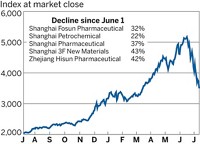Advertisement
Grab your lab coat. Let's get started
Welcome!
Welcome!
Create an account below to get 6 C&EN articles per month, receive newsletters and more - all free.
It seems this is your first time logging in online. Please enter the following information to continue.
As an ACS member you automatically get access to this site. All we need is few more details to create your reading experience.
Not you? Sign in with a different account.
Not you? Sign in with a different account.
ERROR 1
ERROR 1
ERROR 2
ERROR 2
ERROR 2
ERROR 2
ERROR 2
Password and Confirm password must match.
If you have an ACS member number, please enter it here so we can link this account to your membership. (optional)
ERROR 2
ACS values your privacy. By submitting your information, you are gaining access to C&EN and subscribing to our weekly newsletter. We use the information you provide to make your reading experience better, and we will never sell your data to third party members.
Policy
China’s Quest
by Bibiana Campos Seijo
August 3, 2015
| A version of this story appeared in
Volume 93, Issue 31
I’ve been reading a lot about China in the media recently.
First, it was the news of the collapse of the country’s stock markets. The crisis began in mid-June when, despite the markets hitting a seven-year high only a few days earlier, the bubble popped. Chinese shares lost about one-third of their value—more than $3 trillion—in just as many weeks.
Although the government acted quickly and decisively to limit the damage and prop up the market, investors around the world now fear that the turmoil may spill into China’s economy, the second largest in the world, and harm global growth. To learn how this situation may impact chemical and pharma firms in China, you can read Jean-François Tremblay’s account in C&EN (July 13, page 5).
But this does not mean that China is slowing down in other areas. Proof of this is the recently launched, ambitious plan to create a megacity in the heart of China.
The drive for the creation of this megalopolis is to combine the high-tech and cultural industries of Beijing, the port facilities of Tianjin, and Hebei’s resources to create a powerhouse like we haven’t seen before. Currently the area has a population of approximately 130 million, comparable to Japan’s, and it covers 212,000 sq km, a space six times the size of New York City. Besides all the obvious issues surrounding the provision of transport for such a large population and keeping them employed, healthy, and fed, pollution problems are only likely to become exacerbated. Despite some commitment toward moving pollution-creating businesses out of the urban center, it is concerning that air and water quality do not appear to be high in the agenda for planners.
With all this coverage and media attention devoted to China, our supplement “China Looks West” is very timely. The cover story (page 8 of the supplement) is fascinating and provides revealing facts and data. Here’s one: While China is the second-largest pharma market after the U.S., per capita spending on pharmaceuticals is still just 9% that of the U.S. Thus, for China’s pharmaceutical makers, selling products to the developed world continues to be far more profitable than supplying the domestic market. Hence, it is only natural that for years now China has been looking to the West while simultaneously continuing to build manufacturing capacity to supply China’s ever-growing population.
In terms of intellectual property, Chinese patenting activity has been growing at an annual rate of 25% since 2004, according to data provided by Chemical Abstracts Service in “Pharmaceuticals Lead Chinese Patent Applications in 2014” (page 6 of the supplement). Indeed, patents in pharmaceuticals and food are at the top of the list: The megacity is only the tip of the iceberg; the government must ensure that a country as vast as China is healthy and well fed. This is closely followed by patents in the energy area, where, as the largest consumer of energy in the world, China has seen its patent output influenced by research in fuel cells, insulators, etc.
Pharma patents from China exceeded the 16,000 mark in 2014, while the U.S. lags behind at approximately 5,000. Interestingly, most of Chinese patent applications are in the formulation and compounding area, where patents traditionally cover new ways of delivering already patented substances and don’t contain new chemical entities. But while the number of patents published seems to contradict the perception that China does not have a culture of innovation, it’s only a matter of time until this perception changes. There are many hurdles to change this but with such output, the Chinese government now taking IP rights more seriously, and a drive to raise the quality of the enterprise—for example, increased scrutiny of manufacturing plants and more and more anticorruption investigations—this gap in the number of patents is going to get larger and larger.
China is on a quest to become the global leader in science and technology, and the government will provide the means to the Chinese industry to achieve this.
Views expressed on this page are those of the author and not necessarily those of ACS.




Join the conversation
Contact the reporter
Submit a Letter to the Editor for publication
Engage with us on Twitter